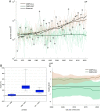Anthropogenic climate change impacts exacerbate summer forest fires in California
- PMID: 37307438
- PMCID: PMC10288651
- DOI: 10.1073/pnas.2213815120
Anthropogenic climate change impacts exacerbate summer forest fires in California
Abstract
Record-breaking summer forest fires have become a regular occurrence in California. Observations indicate a fivefold increase in summer burned area (BA) in forests in northern and central California during 1996 to 2021 relative to 1971 to 1995. While the higher temperature and increased dryness have been suggested to be the leading causes of increased BA, the extent to which BA changes are due to natural variability or anthropogenic climate change remains unresolved. Here, we develop a climate-driven model of summer BA evolution in California and combine it with natural-only and historical climate simulations to assess the importance of anthropogenic climate change on increased BA. Our results indicate that nearly all the observed increase in BA is due to anthropogenic climate change as historical model simulations accounting for anthropogenic forcing yield 172% (range 84 to 310%) more area burned than simulations with natural forcing only. We detect the signal of combined historical forcing on the observed BA emerging in 2001 with no detectable influence of the natural forcing alone. In addition, even when considering fuel limitations from fire-fuel feedbacks, a 3 to 52% increase in BA relative to the last decades is expected in the next decades (2031 to 2050), highlighting the need for proactive adaptations.
Keywords: California; anthropogenic climate change; forest fires.
Conflict of interest statement
The authors declare no competing interest.
Figures



References
-
- Williams A. P., et al. , Observed impacts of anthropogenic climate change on wildfire in California. Earth’s Future 7, 892–910 (2019).
-
- Cal FIRE, Top 20 largest California wildfires (2022). Available at: https://www.fire.ca.gov/media/4jandlhh/top20_acres.pdf.
-
- Higuera P. E., Abatzoglou J. T., Record-setting climate enabled the extraordinary 2020 fire season in the western United States. Glob. Change Biol. 27, 1–2 (2021). - PubMed
-
- Buechi H., Weber P., Heard S., Cameron D., Plantinga A. J., Long-term trends in wildfire damages in California. Int. J. Wildland Fire 30, 757–762 (2021).

